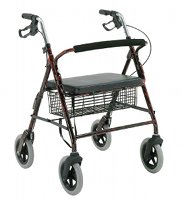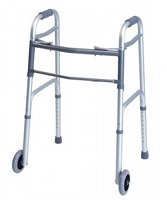Many baby boomers rely on Durable Medical Equipment (DME) supplies for their daily activities. Medicare covers medically necessary supplies such as a wheelchair, CPAP machine, or oxygen tank.
So, if you’re wondering about Medicare coverage on your Durable Medical Equipment; ask yourself this; is this medically necessary and is my doctor going to write a prescription for this?
If you can answer yes, then coverage will be likely.
Will My Medicare Coverage Pay for Durable Medical Equipment?
Durable medical equipment is covered under Medicare Part B. The yearly Part B deductible is applicable and then Medicare pays an 80% coinsurance.
That means the Medicare Beneficiary is responsible for the remaining 20%.
If you’ve purchased secondary coverage through a private insurance company, they may pay the remaining 20% of the equipment costs.
Of course, that is provided you have met the Medicare requirements; like paying any applicable deductibles or premiums.
How Do I Get Medicare To Cover My Durable Medical Equipment?
Medicare requires standard information to be included with all prescriptions for durable medical equipment.
Typically, a face to face office note detailing medical necessity and a prescription.
Occasionally, Medicare may require additional testing or documentation. The DME provider should be able to guide Medicare Beneficiaries through the process.
You can expect equipment to be covered if it provides a therapeutic benefit for a condition or illness and will be used in the home.
Keep in mind that Medicare will cover the base model, any upgrades will be billed to the Medicare Beneficiary.
What If I need Durable Medical Equipment To Be Discharged From The Hospital?
When being sent home from the hospital, most people need a few supplies to make the transition smoother.
The most common prescribed items at the time of hospital discharge are hospital beds, wheelchairs, and bedside commodes.
The items that are necessary for Medicare Beneficiaries to continue recovery in the comfort of their own home, are typically covered.
These items will be covered by your Medicare Part B when the prescription is submitted along with the provider’s progress note detailing your condition and the medical necessity of the equipment.
Depending on the length of need, Medicare may rent or buy the equipment being ordered.
What If I Can’t Get Around My Home?
In some cases, a Medicare Beneficiary may have a long-term need for mobility. This could be due to a disability that is classified as temporary or permanent.
In either event, Medicare will cover a Power Mobility Device (PMD) provided specific criteria have been met.
For example, Medicare will require a face to face office note detailing the disability along with the doctor’s recommendation the patient will benefit from the device.
Provided the PMD is primarily used in the home, it will be considered a covered expense. Just to be clear, the Power Mobility Device can used outside the home.
Other items that improve mobility are:
There are numerous types of walkers and your practitioner will be able to assist you in determining which one would best meet your needs.
What If I Have A Need for Supplemental Oxygen, A Nebulizer or A Ventilator?
These items are all considered durable medical equipment and are covered under your Medicare Part B coverage.
As you know, anything considered a covered expense by Medicare will be considered payable by your Medicare Supplement Plan.
Oxygen is covered when the doctor details in the face to face office note the specific reason for supplemental oxygen. Oxygen is prescribed for persons with conditions such as COPD, also known as emphysema.
Nebulizers are used to atomize liquid medicine so the beneficiary can inhale a mist that will help open the alveoli, or air sacs. Nebulizers are commonly used by persons with asthma and infants.
Ventilators come in many forms and offer different treatment options. Medicare Part B will require a prescription, a face to face office note from the doctor detailing the condition, and the reason this DME is being ordered.
Ventilators can be either invasive or noninvasive.
- An invasive ventilator does require an endotracheal tube which is inserted either through the nose or mouth.
- A noninvasive ventilator requires only a mask.
Both types of ventilation therapy provide a volume and pressure to assist the user and provide support breathing.
What Is the Most Common Durable Medical Equipment Ordered?
Diabetic equipment is the most common equipment prescribed under Medicare Part B. Monitors and strips are covered.
Prosthetics and orthotic equipment that supports the lumbar or cervical spine are frequently prescribed. Personal care items such as bath chairs and dressing aids are also commonly prescribed.
What About My Sleep Apnea?
Medicare Part B does provide coverage for machines that correct obstructive sleep apnea.
These items are called CPAP and BiPAP machine. Depending on the type of sleep apnea, a doctor would allow the machine to correct the Medicare Beneficiaries condition.
Diagnosing sleep apnea is a quick process, but most people don’t know what symptoms should be cause for concern.
Sleep apnea is caused by either a physiological condition where the weight of the neck closes making the person stop breathing or breathe very slow, or a condition where the brain forgets to breathe.
Both are cause for concern because they put added strain on your heart and brain.
Signs to report to your doctor are snoring, insomnia, morning headaches or persistent daytime sleepiness.
What About the Monthly Supplies I Need for Upkeep?
Recurring supply needs are covered by your Medicare Part B coverage. Your DME company will be able to advise the frequency with which you can replace any durable medical equipment supplies.












